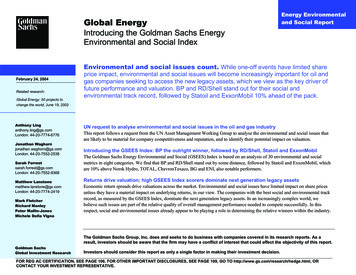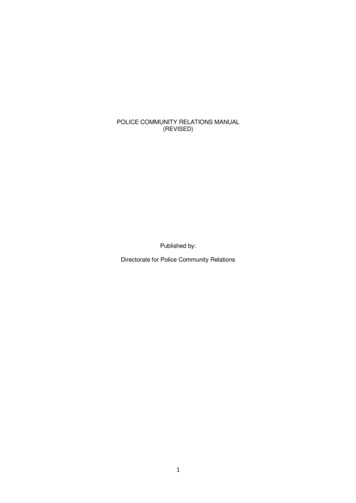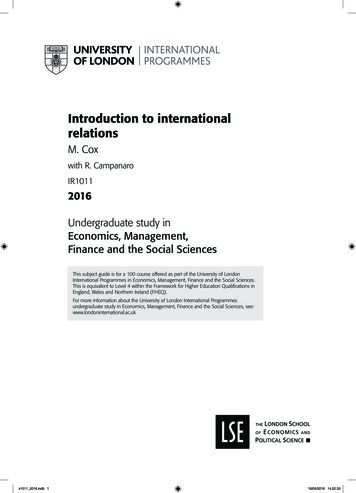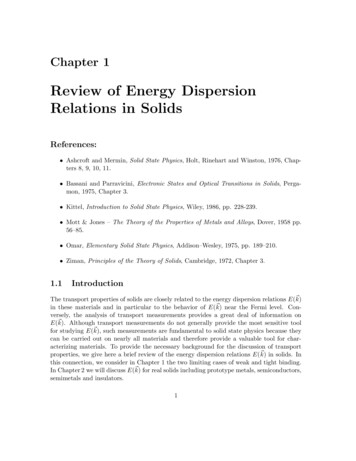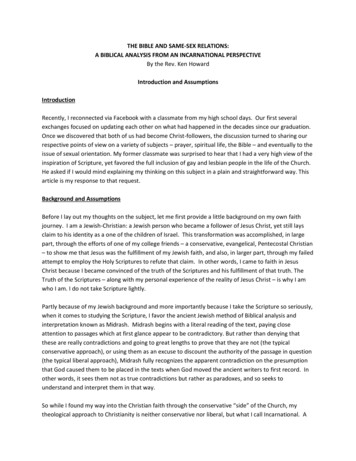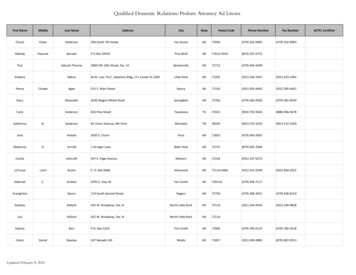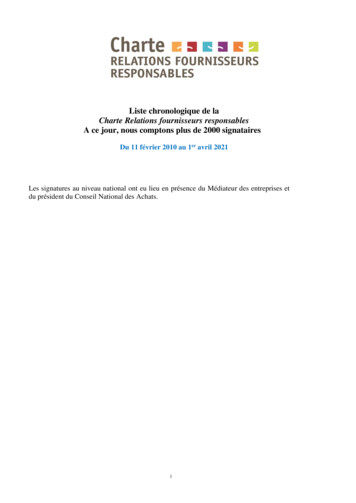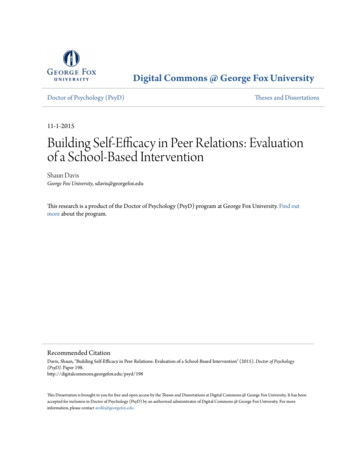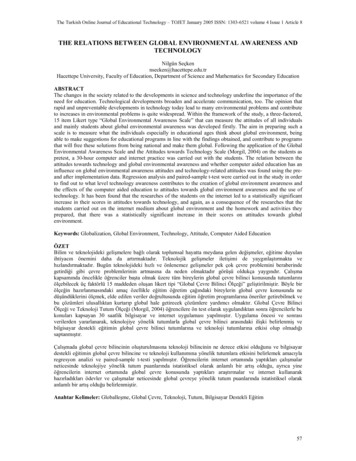
Transcription
The Turkish Online Journal of Educational Technology – TOJET January 2005 ISSN: 1303-6521 volume 4 Issue 1 Article 8THE RELATIONS BETWEEN GLOBAL ENVIRONMENTAL AWARENESS ANDTECHNOLOGYNilgün Seçkennsecken@hacettepe.edu.trHacettepe University, Faculty of Education, Department of Science and Mathematics for Secondary EducationABSTRACTThe changes in the society related to the developments in science and technology underline the importance of theneed for education. Technological developments broaden and accelerate communication, too. The opinion thatrapid and unpreventable developments in technology today lead to many environmental problems and contributeto increases in environmental problems is quite widespread. Within the framework of the study, a three-factored,15 item Likert type “Global Environmental Awareness Scale” that can measure the attitudes of all individualsand mainly students about global environmental awareness was developed firstly. The aim in preparing such ascale is to measure what the individuals especially in educational ages think about global environment, beingable to make suggestions for educational programs in line with the findings obtained, and contribute to programsthat will free these solutions from being national and make them global. Following the application of the GlobalEnvironmental Awareness Scale and the Attitudes towards Technology Scale (Morgil, 2004) on the students aspretest, a 30-hour computer and internet practice was carried out with the students. The relation between theattitudes towards technology and global environmental awareness and whether computer aided education has aninfluence on global environmental awareness attitudes and technology-related attitudes was found using the preand after implementation data. Regression analysis and paired-sample t-test were carried out in the study in orderto find out to what level technology awareness contributes to the creation of global environment awareness andthe effects of the computer aided education to attitudes towards global environment awareness and the use oftechnology. It has been found that the researches of the students on the internet led to a statistically significantincrease in their scores in attitudes towards technology, and again, as a consequence of the researches that thestudents carried out on the internet medium about global environment and the homework and activities theyprepared, that there was a statistically significant increase in their scores on attitudes towards globalenvironment.Keywords: Globalization, Global Environment, Technology, Attitude, Computer Aided EducationÖZETBilim ve teknolojideki gelişmelere bağlı olarak toplumsal hayatta meydana gelen değişmeler, eğitime duyulanihtiyacın önemini daha da artırmaktadır. Teknolojik gelişmeler iletişimi de yaygınlaştırmakta vehızlandırmaktadır. Bugün teknolojideki hızlı ve önlenemez gelişmeler pek çok çevre problemini beraberindegetirdiği gibi çevre problemlerinin artmasına da neden olmaktadır görüşü oldukça yaygındır. Çalışmakapsamında öncelikle öğrenciler başta olmak üzere tüm bireylerin global çevre bilinci konusunda tutumlarınıölçebilecek üç faktörlü 15 maddeden oluşan likert tipi “Global Çevre Bilinci Ölçeği” geliştirilmiştir. Böyle birölçeğin hazırlanmasındaki amaç özellikle eğitim öğretim çağındaki bireylerin global çevre konusunda nedüşündüklerini ölçmek, elde edilen veriler doğrultusunda eğitim öğretim programlarına öneriler getirebilmek vebu çözümleri ulusallıktan kurtarıp global hale getirecek çözümlere yardımcı olmaktır. Global Çevre BilinciÖlçeği ve Teknoloji Tutum Ölçeği (Morgil, 2004) öğrencilere ön test olarak uygulandıktan sonra öğrencilerle bukonuları kapsayan 30 saatlik bilgisayar ve internet uygulaması yapılmıştır. Uygulama öncesi ve sonrasıverilerden yararlanarak, teknolojiye yönelik tutumlarla global çevre bilinci arasındaki ilişki belirlenmiş vebilgisayar destekli eğitimin global çevre bilinci tutumlarına ve teknoloji tutumlarına etkisi olup olmadığısaptanmıştır.Çalışmada global çevre bilincinin oluşturulmasına teknoloji bilincinin ne derece etkisi olduğunu ve bilgisayardestekli eğitimin global çevre bilincine ve teknoloji kullanımına yönelik tutumlara etkisini belirlemek amacıylaregresyon analizi ve paired-sample t-testi yapılmıştır. Öğrencilerin internet ortamında yaptıkları çalışmalarneticesinde teknolojiye yönelik tutum puanlarında istatistiksel olarak anlamlı bir artış olduğu, ayrıca yineöğrencilerin internet ortamında global çevre konusunda yaptıkları araştırmalar ve internet kullanarakhazırladıkları ödevler ve çalışmalar neticesinde global çevreye yönelik tutum puanlarında istatistiksel olarakanlamlı bir artış olduğu belirlenmiştir.Anahtar Kelimeler: Globalleşme, Global Çevre, Teknoloji, Tutum, Bilgisayar Destekli Eğitim57
The Turkish Online Journal of Educational Technology – TOJET January 2005 ISSN: 1303-6521 volume 4 Issue 1 Article 8INTRODUCTIONA common understanding in the scientific world is the rapid change and development we live today. Theunprecedented technological developments, computers, the internet, television, the developments in outreach andcommunications in short, have reduced the dimensions of the world geography and made the individuals in thesociety informed about everywhere (Cornoy; Courtivron, 2000). Concepts like globalization, new world order,postmodernism, localization, and neo-liberalism are being used to mean each other recently (Mortimore, 2001).The word “globe”, the root of globalization, means a three-dimensional physical shape as well as the earth, theworld we live on.When the histories of all the countries are examined, being able to rule the world and the resources can be seenas the – nearly – only aim. Therefore, the history of globalization can be dated back to the emerging of religionsand empires. The objective in global education is to free those people from different nations with differentcultures from these differences (Van der Wende, 2003). It is to dispose of different stereotypes by giving auniversal history awareness and universal culture, thus achieve the aim of creating a “uniform human type”. Thebiggest hindrance in front of globalization is the nationalistic awareness of people from different cultures. It isinevitable that people educated in different educational institutions have different opinions of life andphilosophies of living. The ultimate influence of globalization on education is inevitable (Kell, 1999). Hence, theconcept of globalization is a course in graduate and doctorate programs in developed countries. On the otherhand, there are serious conflicts of opinions as to how globalization will affect educational systems. Theassumption that the differences in educational systems will reduce parallel to the globalization process seems asa natural result of globalization (Lyons, 2000; David, 1999). Educational projects implemented by organizationssuch as the World Bank and UNICEF can be considered as activities targeted to uniform educational systems.The duty bestowed on institutions of higher education today is the function of bringing up able staff with suitableprofessions for the labor market. With globalization in place, students that want to study at universities shouldfind a way in the society of knowledge and technology. The educational problems we encounter are mainlybased on the failure to fully understand the reflections of globalization and transforming into the society ofknowledge as well as the rapid changes in information technologies on education and environment and therefore,taking the required measures (Beerken, 2003).For us, globalization is more production than consuming. This can only be achieved by creating a true nationalawareness and identity. Therefore, educators have important tasks to accomplish, and based on that, a processthat can be realized through education is in question. Accordingly, the human being is in the centre. There arethree professions (sciences) that should place the human being in the centre. The first one is medicine thataffords health to people; the second is law that bestows rights and draws the framework of these rights; andthe profession of teaching that compasses all of these.In his studies on school learning, Bloom (1979) has examined the entry behaviors that cover the past livings andnatural and acquired competencies as related to behaviors that the students are desired to acquire in two groupsnamely cognitive entry behaviors and affective entry characteristics. Affective entry characteristics consist ofseveral convictions related to the attitude that the individual develops against the school and the learningexperiences at school, the academic self concept of the individual, that is how competent s/he feels as a result oftheir comparison of themselves with other individuals carrying out he same activity. The entry behaviors thatconsist of cognitive and affective entry characteristics are open to change. That is to say that they can be learned,taught, and developed with appropriate methods. The researches indicate that cognitive entry behaviors explain50 percent of the differences in student success whereas affective entry characteristics explain only 15 percent.Today, the environment has become a main concern for the world. Pollutions in the seas, rivers, the atmosphere,and wherever we can think of are a global problem (Lisowski, 1993; Trisler, 1993). The polluting of a riverspringing in our lands is not a local problem anymore, but a global one. The atmospheric pollution or nuclearactivities harming environment in the USA or anywhere of the world are not problems of the country where theytake place but have turned to be the problems of the whole world. The consequences of the disaster in Chernobylthat happened years ago are suffered not only by the country where the explosion took place but also by the restof the world. When the fact that people from different cultures act with a nationalistic awareness, which is seenas one of the biggest problems of globalization, is taken into consideration, it will be inevitable for us to face thefact that it would not be easy to find a solution to environmental problems. Since hindering technologicaldevelopments cannot be a matter to consider, looking for global solutions to environmental issues and creatingglobal environmental awareness has become inevitable (Lisowski and Williams, 1993; Lo Presti and Garafalo,58
The Turkish Online Journal of Educational Technology – TOJET January 2005 ISSN: 1303-6521 volume 4 Issue 1 Article 81994). On the other hand, technology is a requisite of development, advancement, and facilitating living.Therefore, giving up technology and technological advancements cannot be considered as an option.THE PURPOSE OF THE STUDYGlobalization has a direct relation with technological improvements. According to Tozum on this, “globalizationis a technology-centered change process; and novelties such as computerization, telecommunicationtechnologies, minimalism, compression technology, and digitalization make technology prevalent on the globalscale (Tozum, 2002)”. Technological developments also broaden and accelerate communication. The opinionthat rapid and unpreventable developments in technology today lead to many environmental problems andcontribute to increases in environmental problems is quite widespread.Within the framework of the study, preparing an attitude scale that can measure the attitudes of all individualsand mainly students about global environmental awareness was planned primarily. The aim in preparing such ascale is to measure what the individuals especially in educational ages think about global environment, beingable to make suggestions for educational programs in line with the findings obtained, and contribute to programsthat will free these solutions from being national and make them global. The relations between the attitudestowards technology and global environmental awareness and whether computer aided education has an influenceon the development of global environmental awareness have been aimed to be identified with the help of theprepared scale. The technological attitudes scale used within the scope of the study was prepared by Yavuz(2004) and analyzed by Morgil and Yucel (2004).When making suggestions or taking measures related to global environmental awareness utilizing such scales,more lasting and more efficient solutions can be explored by thinking globally instead of locally. Because, withthe help of such a scale, human profiles in all levels such as the students at schools, people in the street, laborersat workplaces, housewives at homes, people in general from all professions and all educational andsocioeconomic levels can be prepared to produce country profiles to identify how people living in a country lookat the issue of global environmental awareness and thus, more efficient solution suggestions can be madeworldwide. Support can be taken from sections that consider the issue with a higher awareness level. Because,the environment has no more a problem peculiar only to a single country, a continent or a region, but turned to aproblem of the global world (Tognacci, L. H., 1972). The solutions to environmental problems will only bepossible with global measures. The place and importance of technology in looking at global environmentalproblems and solution approaches will also be an important factor of the measures to be taken.Mathematics teachers and educators believe that whether the students like mathematics or are interested inmathematics lesson or not affect their success (Suydam and Weaver, 1975). Similarly, that the attitudes towardschemistry have an important role in student success has been proven by research studies (Moneim, Hassan, andShrigley, 1984). Such a study was planned based on the idea that the same effect also applies to the success inbringing about solutions to global environmental problems, which have turned the most important
universal history awareness and universal culture, thus achieve the aim of creating a “uniform human type”. The biggest hindrance in front of globalization is the nationalistic awareness of people from different cultures. It is inevitable that people educated in different educational institutions have different opinions of life and philosophies of living. The ultimate influence of .

